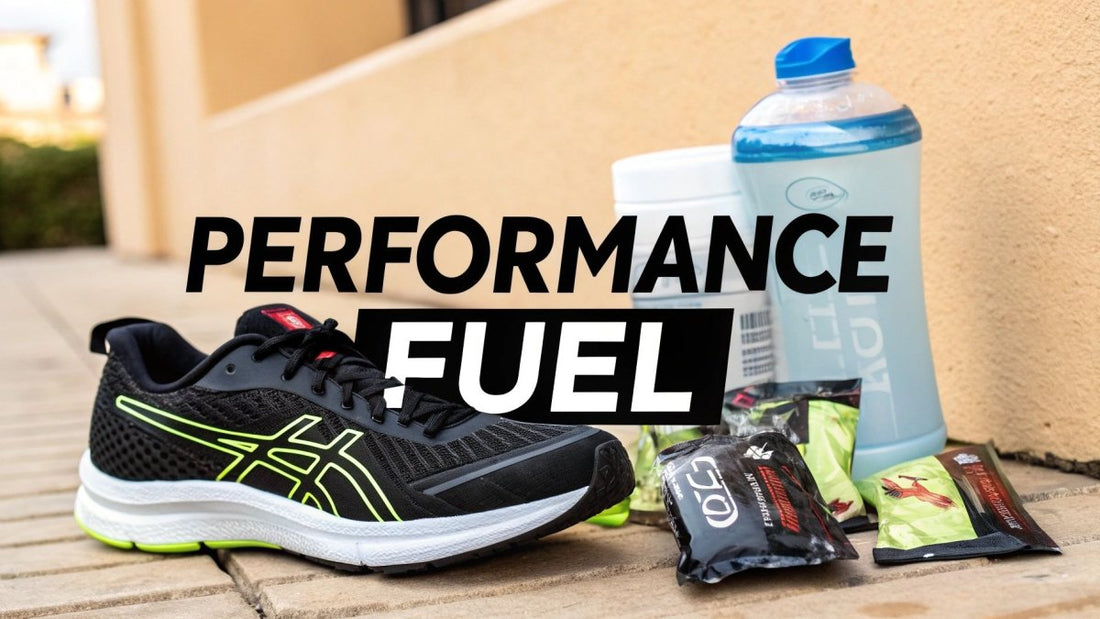
Nutrition for Endurance Athletes Performance Fuel
Share
Proper nutrition for endurance athletes is much more than just eating healthy. It’s a carefully timed, strategic approach to fueling your body for the long haul. Think of it as the science of knowing what to eat, when to eat it, and how to stay hydrated so you can sustain peak performance, fight off fatigue, and bounce back faster after a tough session.
Why Your Nutrition Strategy Is Your Secret Weapon
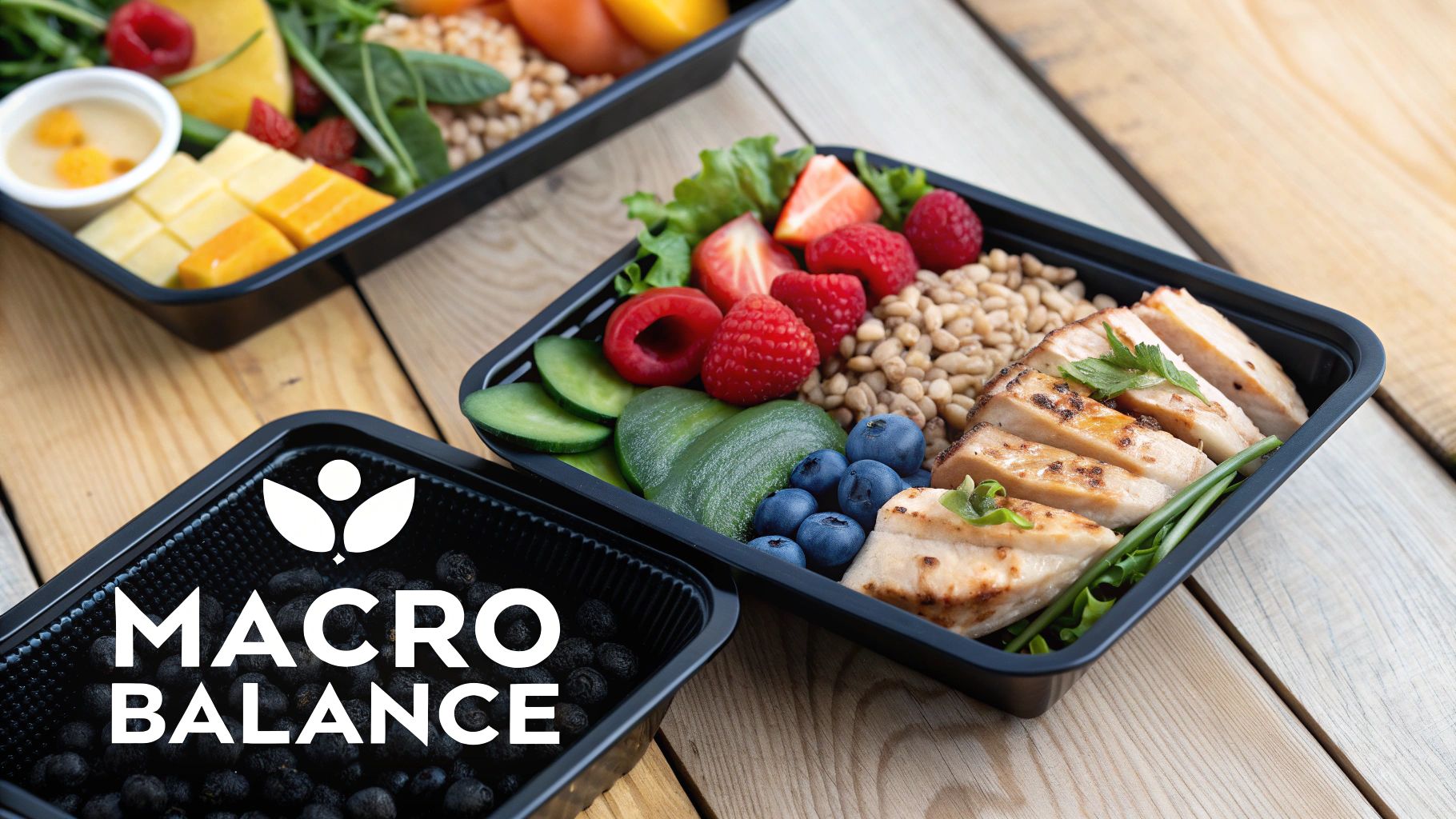
Imagine your body is a high-performance engine. You wouldn't put just any gas in a race car, right? You'd use a specific, high-octane fuel blend designed for winning. Your body is no different. It needs a sophisticated nutrition strategy that goes way beyond generic health advice.
For any endurance athlete, food isn't just about survival; it's a critical performance tool. Your ability to push through those grueling final miles—whether you're running, cycling, or swimming—is directly linked to the quality and timing of every single thing you consume.
Moving Beyond The Basics
Forget those one-size-fits-all meal plans you see online. A truly effective nutrition plan for an endurance athlete has to be personal and flexible. It’s all about understanding how to adjust your macronutrients to match different training phases and race-day conditions.
This means knowing exactly when to load up on quick-burning carbohydrates for a sudden burst of energy versus when to lean on slow-burning fats to sustain your effort over several hours.
A solid, personalized framework is built on a few key pillars:
- Strategic Fueling: Mastering your macros to deliver the right kind of energy at precisely the right time.
- Intelligent Hydration: Carefully balancing fluid and electrolyte intake to stave off dehydration and cramping.
- Optimized Recovery: Timing your post-workout nutrition perfectly to kickstart muscle repair and restock your energy stores.
This laser-focus on nutrition is a big deal. The global sports nutrition market, which is essential for endurance athletes, was valued at around USD 55.90 billion recently. As more people take on marathons and triathlons, that number is only expected to climb. You can dive deeper into these sports nutrition market trends on Fortunebusinessinsights.com.
The real goal is to create a seamless synergy between your training and your diet. When your nutrition works in perfect harmony with your physical effort, you can sustain energy, prevent the dreaded "bonk," and cross the finish line stronger than ever.
Ultimately, mastering your nutrition is about giving yourself a competitive edge. It's the invisible training that happens off the track and on your plate, unlocking the power you need to smash your performance goals.
Mastering Your Macronutrient Mix
Think of your body's energy system like a hybrid car. It doesn't rely on just one fuel source; it cleverly switches between different ones depending on the demand. Macronutrients—carbohydrates, protein, and fat—are your body’s fuels, and learning how to blend them is the bedrock of smart endurance nutrition.
Each macro plays a distinct and vital role. Carbohydrates are your high-octane gasoline, essential for hitting top speed and powering up hills. Protein is the dedicated repair crew that rebuilds your engine after a tough workout. And fat? That's your ultra-efficient diesel fuel, reliably powering you over those long, steady distances.
Getting this mix right isn't about restrictive dieting. It's about strategic fueling that ensures you never run out of gas, no matter how demanding the course.
Here’s a quick overview of how these three powerhouses work together.
Macronutrient Guide for Endurance Athletes
This table breaks down the essentials for each macronutrient, giving you a clear roadmap for what to eat and why.
| Macronutrient | Primary Role in Endurance | Recommended Daily Intake | Best Food Sources |
|---|---|---|---|
| Carbohydrates | Main source of high-intensity fuel; stored as glycogen in muscles and liver. | 5-12 g per kg of body weight, depending on training intensity. | Oats, rice, potatoes, whole-wheat pasta, fruits, sports gels, energy chews. |
| Protein | Repairs muscle damage, supports recovery, and builds stronger muscle tissue. | 1.4 g per kg of body weight. | Lean meats, fish, eggs, dairy, beans, lentils, tofu, whey or plant-based protein powders. |
| Fat | Provides long-lasting, low-intensity energy; essential for hormone production. | 20-30% of total daily calories. | Avocados, nuts, seeds, olive oil, fatty fish like salmon. |
Balancing these three is what separates good performance from great performance. Now, let's dig into the specifics of each one.
Carbohydrates: The High-Octane Fuel
For any endurance athlete, carbohydrates are king. They are, without a doubt, your most critical fuel source for performance. When you eat carbs, your body converts them into glucose and stores them in your muscles and liver as glycogen.
Think of your glycogen stores as a full tank of premium gas, ready to be burned the second you demand speed or power. If those stores run dry, you hit the dreaded "wall"—that feeling where your body simply refuses to go any further. Keeping them topped off is priority number one.
Not all carbs are created equal, and timing is everything.
- Simple Carbohydrates: Found in sports gels, chews, and fruit, these are your quick-hit energy source. They digest rapidly, making them perfect for a pre-workout boost or mid-race fueling.
- Complex Carbohydrates: These come from foods like oats, sweet potatoes, and brown rice. They provide a slower, more sustained energy release, ideal for meals that keep your tank full throughout the day.
During long events, your glycogen stores inevitably deplete. This is where in-race fueling comes in. Solid research shows that taking in 30 to 60 grams of carbohydrates per hour for any activity lasting over two hours can dramatically postpone fatigue. This strategy keeps your blood sugar stable and your muscles firing on all cylinders. This growing understanding of athletic needs is a major driver of the industry, as highlighted in the Global Sports Nutrition Market Report.
Protein: The Muscle Repair Crew
While carbs fuel the work, protein handles the cleanup and rebuilding. Every single training session creates tiny microscopic tears in your muscle fibers. Protein provides the amino acids—the essential building blocks—your body needs to patch up that damage, making your muscles stronger and more resilient than before.
Skipping on protein is like trying to fix a house without any nails or wood. It just doesn't work. Without enough protein, your body can't recover effectively, which leads to nagging soreness, persistent fatigue, and a much higher risk of injury.
Endurance athletes simply need more protein than the average person. A good target to shoot for is 1.4 grams of protein per kilogram of body weight each day. This gives your body plenty of raw material for the constant repair and adaptation your training demands. Great sources include lean meats, fish, eggs, dairy, beans, lentils, and tofu.
Fats: The Long-Haul Energy Reserve
Fats have had a complicated past, but for endurance athletes, they are an absolutely crucial, long-lasting energy source. Your body holds a nearly unlimited supply of energy in its fat stores, making it the perfect fuel for lower-intensity, long-duration efforts.
Here’s a simple way to think about it: glycogen from carbs is your sprint fuel, while fat is your marathon fuel. As you chug along at a steady pace, your body gets better and better at tapping into fat for energy. This adaptation is a huge advantage because it spares your limited glycogen stores for when you really need them, like for a final kick or a steep climb.
By training your body to efficiently use fat as fuel, you effectively expand your fuel tank. This metabolic flexibility is a key advantage for any endurance athlete, allowing you to go longer and stronger before needing to refuel.
The key is to focus on healthy unsaturated fats. You'll find these in foods like:
- Avocados
- Nuts and seeds
- Olive oil
- Fatty fish (like salmon)
These fats don't just provide energy; they also help reduce inflammation and support overall health. Aim to get about 20-30% of your daily calories from healthy fat sources to keep your body and its systems running smoothly.
The Science of Smart Hydration
Think of proper hydration as the cooling system for your athletic engine. It’s what stops you from overheating on a long run or ride and keeps every part of your body firing on all cylinders. This is a massive piece of the nutrition for endurance athletes puzzle, but it's so often boiled down to "drink when you're thirsty." True performance hydration is way more strategic than that; it's about maintaining a precise fluid balance and replacing the critical minerals you sweat out.
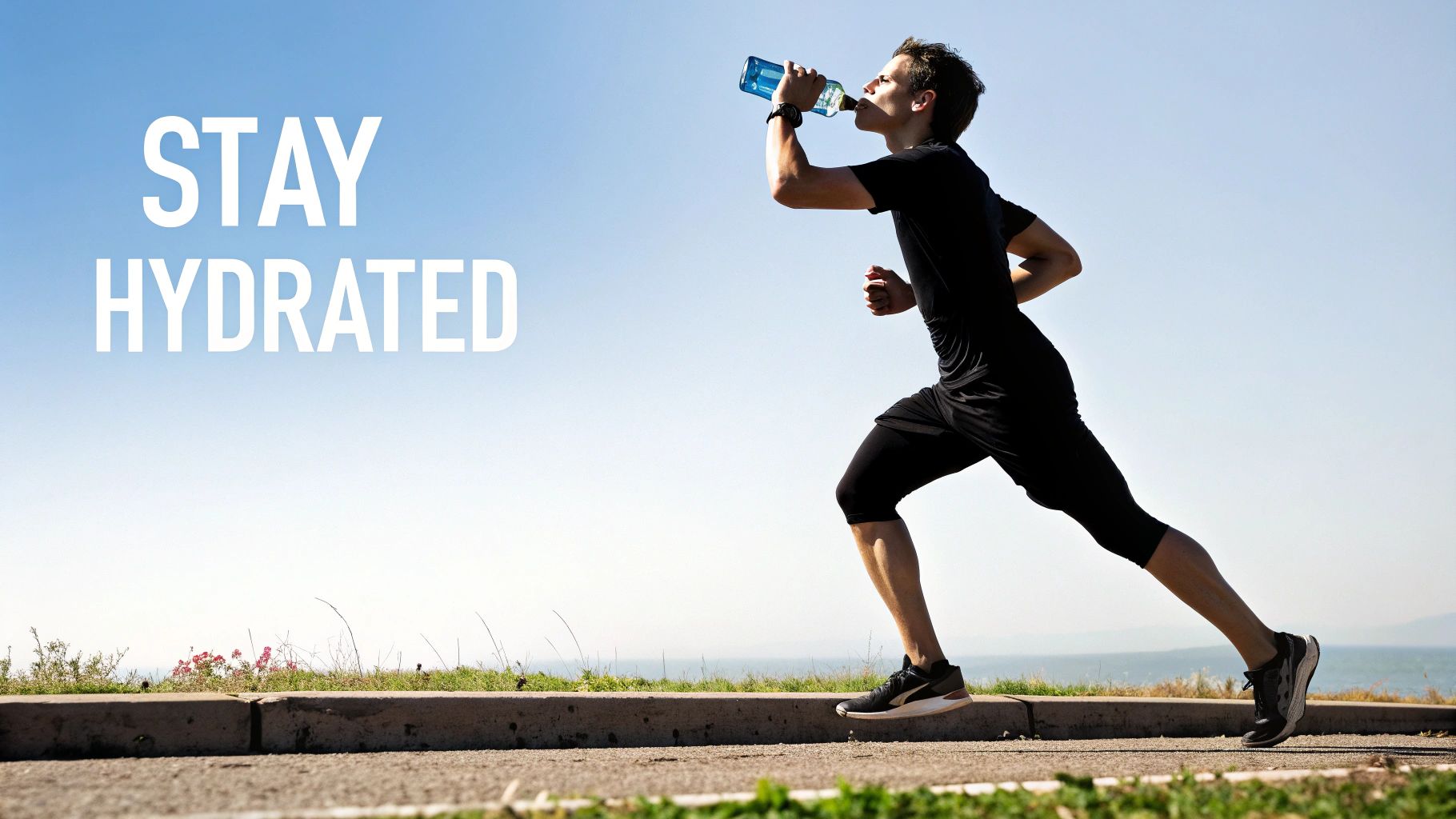
Even a tiny bit of dehydration can hit your performance like a ton of bricks. If you lose just 2% of your body weight in sweat, you’re already looking at a drop in power, a weaker aerobic capacity, and that feeling where everything suddenly seems way harder than it should. For anyone serious about hitting their endurance goals, a smart hydration plan isn't a "nice-to-have"—it's a non-negotiable.
Figure Out Your Personal Sweat Rate
Here’s the thing: we’re all different. Your sweat rate is unique to you, influenced by your genetics, how used to the heat you are, and how hard you’re pushing it. A generic "drink X ounces every hour" rule just doesn't cut it. To really dial in your hydration, you have to get personal and figure out your own sweat rate.
It’s actually pretty simple to calculate:
- Pre-Workout Weigh-In: Weigh yourself completely nude right before a one-hour training session.
- Track Your Fluids: Keep a close eye on exactly how much you drink during that hour.
- Post-Workout Weigh-In: Once you’re done, towel off completely and get back on the scale, again nude.
- Crunch the Numbers: Add the weight you lost to the amount of fluid you drank.
Let’s say you lost one pound (16 ounces) and drank 16 ounces during your workout. Your personal sweat rate is 32 ounces per hour. Boom. That's your starting point for building a hydration plan that actually works for you.
Your sweat rate is a powerful piece of data. Knowing this allows you to move from guessing to a precise, proactive hydration strategy that prevents dehydration before it ever starts to compromise your performance.
This proactive mindset is key not just for hydration but for building your overall athletic engine. A well-hydrated body is simply more resilient, making it a critical foundation when you're looking into how to improve stamina for those long-haul events.
The Make-or-Break Role of Electrolytes
Water is only half the battle. When you sweat, you’re not just losing H2O; you’re losing electrolytes. Think of electrolytes as the spark plugs for your muscles and nerves—they’re minerals that carry tiny electrical charges, and they are absolutely essential for keeping the body running.
For endurance athletes, these are the big ones:
- Sodium: This is the main one you lose in sweat. It’s the king of maintaining fluid balance, nerve signals, and muscle contractions.
- Potassium: Works hand-in-hand with sodium to manage fluid levels and is a key player in preventing muscle cramps.
- Magnesium: Has a big job in energy production and helping your muscles relax.
- Calcium: You need it for your muscles to contract effectively.
If you keep losing these minerals without putting them back in, you risk muscle cramping, fatigue, and even a dangerous condition called hyponatremia (critically low blood sodium).
Water vs. Sports Drinks: When to Use What
So, when is plain water enough, and when do you need a sports drink? A good rule of thumb is to look at how long and how hard you’re working out.
- Workouts under 60 minutes: For most shorter or less intense sessions, plain water will do the trick. Your body has enough electrolytes stored up to get you through.
- Workouts over 60-90 minutes: This is where a sports drink with carbs and electrolytes becomes essential. The carbs give you a steady stream of quick energy, and the electrolytes are there to replace what you're sweating out, helping you stay strong and cramp-free.
At the end of the day, smart hydration is all about knowing your own body and planning ahead. By figuring out your sweat rate and respecting the crucial role of electrolytes, you can build a strategy that keeps your engine cool, your muscles firing, and your performance right where you want it.
Perfecting Your Nutrient Timing
For any serious endurance athlete, understanding what to eat is only half the battle. The other, equally important piece of the puzzle is when you eat it.
Think of nutrient timing as the choreography between your fuel and your effort. When you get it right, your body has the energy it needs to perform, the grit to push through, and the raw materials to repair itself afterward. Eating the right thing at the right time is what unlocks the full power of your nutrition plan.
Without smart timing, you're just not getting the most out of your meals. It’s like filling up your car with premium gas only after you've already sputtered to a stop on the side of the highway. It’s too little, too late. This strategic approach is a cornerstone of effective nutrition for endurance athletes, turning your food into a high-performance tool.
Pre-Workout Fuel: The Ignition Sequence
The goal before a workout is simple: top off your energy stores without upsetting your stomach. You want to start with a full tank of easily accessible fuel, not a heavy meal sitting in your gut. This is definitely not the time for a big, greasy, or fiber-heavy meal, which can slow digestion and lead to cramps or discomfort.
The focus here is on carbohydrates that your body can break down quickly. An ideal pre-workout meal, eaten about one to two hours before you start, should deliver around 1 gram of carbohydrate per kilogram of body weight. This gives your body just enough time to process that fuel and have it ready for your working muscles.
A few solid pre-workout options are:
- A banana drizzled with honey
- A small bowl of oatmeal
- Toast with jam
- A low-fat, low-fiber energy bar
Remember, training days are for experimenting. Never try anything new on race day!
Intra-Workout Fueling: Keeping the Engine Running
Once you push past the 90-minute mark in a workout, your body's stored glycogen (your primary fuel source) starts to run dangerously low. This is where fueling during your session becomes absolutely critical to avoid "hitting the wall." The objective is to drip-feed your system a steady stream of fast-absorbing carbs to keep blood sugar stable and preserve what's left of your muscle glycogen.
For most long-duration efforts, the standard advice is to take in 30-60 grams of carbohydrates per hour. For ultra-endurance events that go on for many hours, that number can climb as high as 90 grams per hour, often from a mix of sources like glucose and fructose to maximize how much your gut can absorb.
Fueling during your workout is a proactive strategy, not a reactive one. The moment you feel your energy dip, you're already behind schedule. Start taking in small, consistent amounts of fuel early and often to stay ahead of fatigue.
This is exactly what sports gels, chews, and drinks are designed for. They provide a quick, easily digestible shot of energy. And don't forget hydration—sipping fluids every 15-20 minutes is just as important for replacing what you lose through sweat.
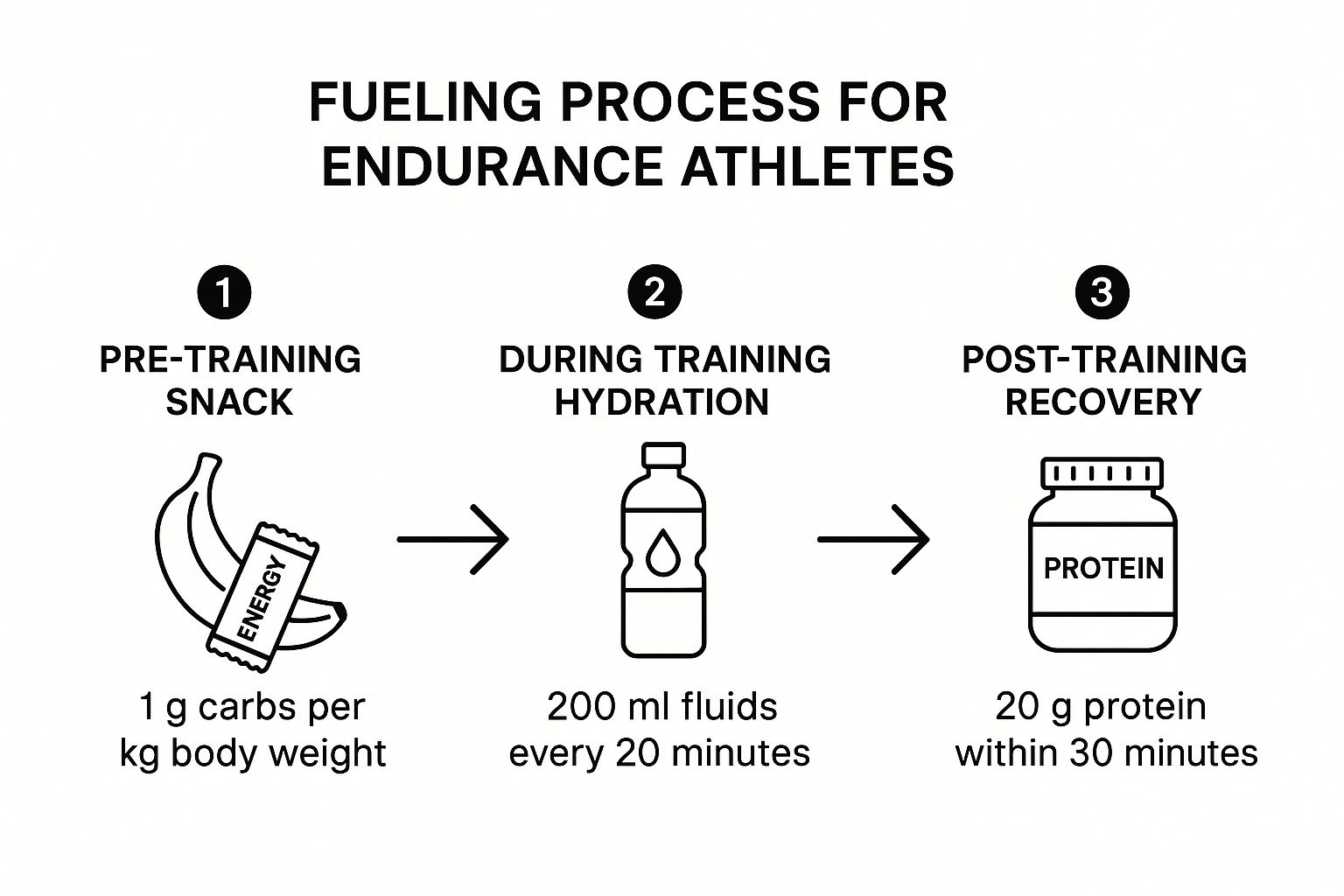
This visual guide breaks down the simple but powerful three-step process, reinforcing how what you consume before, during, and after your workout directly impacts both your performance and your recovery.
Post-Workout Recovery: The Repair Window
The minutes right after a tough workout might just be the most important part of your training day. Your muscles are like sponges, completely primed to soak up nutrients to kickstart the repair and rebuilding process. This "recovery window" is your golden opportunity to restock your energy stores and get a head start on muscle protein synthesis.
If you delay your post-workout fuel, you're only slowing down recovery, increasing muscle soreness, and compromising your ability to go hard in your next session. The mission is simple: get the right nutrients in, and get them in fast.
To make the most of this window, aim to eat a combination of carbs and protein within 30-60 minutes of finishing. The magic formula is a carbohydrate-to-protein ratio of around 3:1 or 4:1. The carbs get to work refilling the glycogen tanks you just emptied, while the protein provides the essential amino acids needed to repair those tired muscle fibers.
A great recovery meal or shake should contain:
- 1.0-1.5 grams of carbohydrate per kilogram of body weight to rapidly replenish glycogen.
- 15-25 grams of high-quality protein to kick off muscle repair.
Simple but effective choices include a fruit smoothie with protein powder, a glass of chocolate milk, or a balanced meal like grilled chicken with a large sweet potato. When you nail your post-workout nutrition, you ensure that all your hard work actually translates into real fitness gains, making you stronger for whatever comes next.
To put it all together, here’s what a sample fueling plan could look like for a long training session.
Nutrient Timing Strategy for a Long Endurance Session
| Phase | Timing | Goal | Example Fueling Strategy |
|---|---|---|---|
| Pre-Workout | 1-2 hours before | Top off glycogen stores | Small bowl of oatmeal with a banana and honey. Sip on water. |
| During Workout | Every 20-30 minutes | Maintain blood glucose & hydration | 1 energy gel (25g carbs) every 30 mins. Sip sports drink consistently. |
| Post-Workout | Within 30-60 minutes | Replenish glycogen & repair muscle | Recovery shake with 20g protein & 60g carbs (e.g., fruit & protein powder). |
| Post-Workout | 2-3 hours after | Continue recovery with a full meal | Balanced meal: Grilled salmon, quinoa, and a large serving of roasted vegetables. |
This table provides a practical framework, but remember that the perfect strategy is always the one that is personalized to your body, your sport, and your specific training goals.
Supplements That Actually Move the Needle
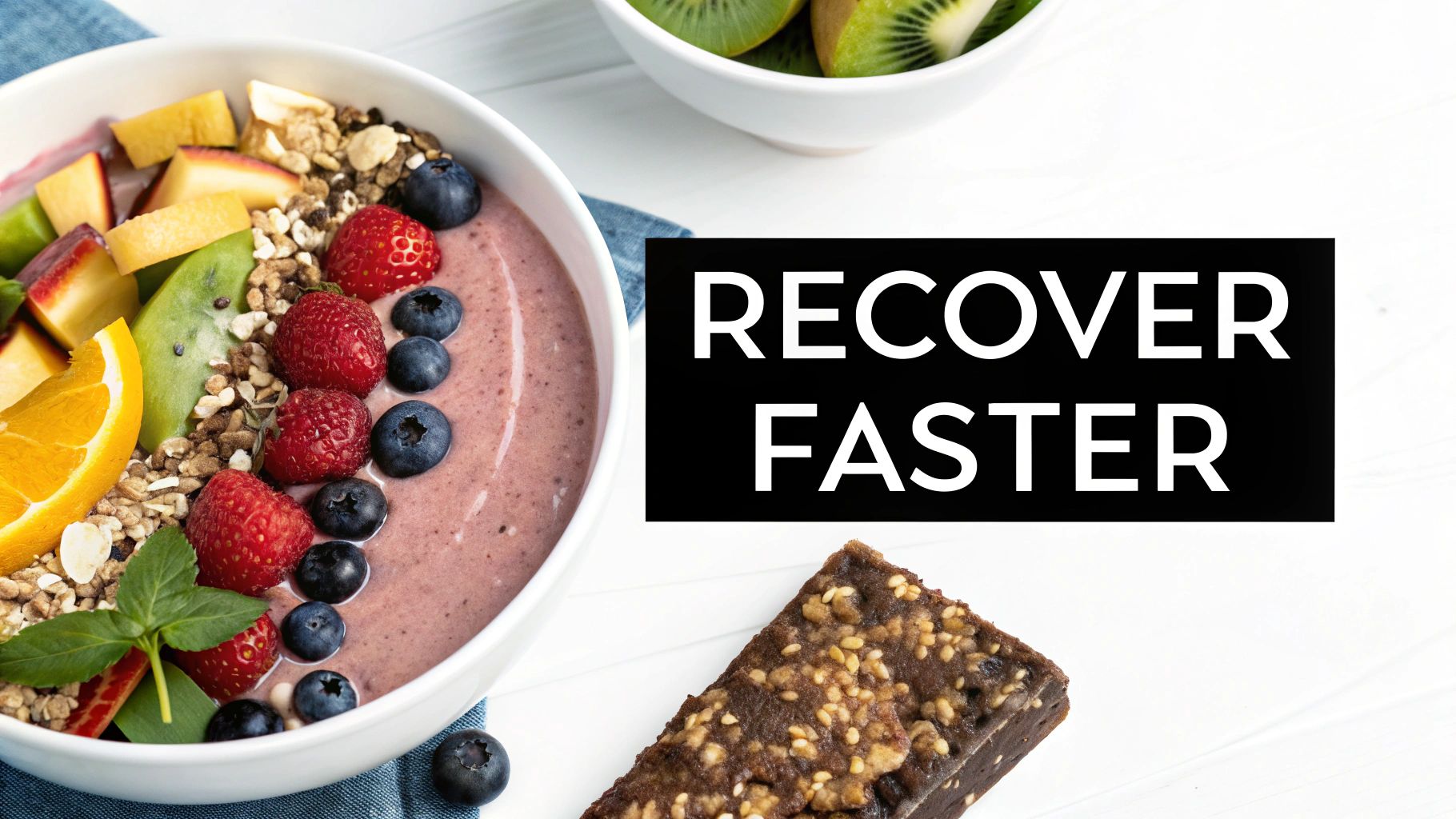
Let's be honest: navigating the world of sports supplements can feel like walking through a minefield of hype and bold claims. For every effective product, there are a dozen that don't live up to their promises.
But for the dedicated endurance athlete, a few select, science-backed supplements can genuinely provide a performance edge. The key is to remember the golden rule: food first. Supplements are not a magic bullet or a replacement for a solid nutrition plan. Think of them as tools to fill specific gaps and fine-tune your performance.
This strategic approach is a big reason the global sports nutrition market hit a value of USD 58.72 billion and continues to climb. Athletes are constantly searching for reliable ways to recover faster, get stronger, and push their endurance limits. If you're curious about the numbers behind the industry, you can learn more about the sports nutrition industry insights over on imarcgroup.com.
Our job is to cut through the noise and focus on what truly works—the proven performers that stand up to scientific scrutiny and deliver real results on the road or trail.
Proven Performers for Endurance
When we talk about nutrition for endurance athletes, a few supplements consistently rise to the top. These aren't miracle pills; they are targeted aids that support the specific systems we tax during long, grueling activities.
-
Caffeine: There’s a reason your pre-race coffee feels so good. Caffeine is one of the most thoroughly researched performance enhancers out there. It works by lowering your perception of effort, which can make those tough miles feel a little bit easier. It also sharpens mental focus and can even encourage your body to burn more fat for fuel, sparing your precious glycogen stores. The sweet spot is typically 3-6 mg per kilogram of body weight, taken about an hour before you start.
-
Electrolytes: These are absolutely non-negotiable. During long, sweaty sessions, you lose critical minerals like sodium, potassium, and magnesium. These aren't just for hydration—they're essential for muscle contractions and nerve function. If you’ve ever suffered from debilitating cramps, an electrolyte imbalance was likely the culprit. Powders or tablets are an easy way to stay on top of your needs.
-
Creatine: Most people associate creatine with bodybuilders, but it has some fantastic, often overlooked, benefits for endurance athletes. Creatine helps rapidly regenerate ATP, your body's source of instant energy. This is incredibly useful for short, intense bursts like a steep hill climb or a sprint to the finish line. A steady daily dose of 3-5 grams can help boost your power output and even protect muscle mass during heavy training blocks.
The best supplement strategy is both minimalist and highly targeted. Focus on products that solve a specific problem you're facing, whether that's cramping, mid-race brain fog, or slow recovery.
How to Choose Safe and Effective Products
Here’s the tricky part: the supplement industry isn’t regulated like pharmaceuticals. This puts the responsibility on you, the athlete, to be a smart consumer. The last thing you want is an expensive product that doesn’t work, or worse, one that contains banned or harmful substances.
Your number one priority should always be verifying the quality and safety of anything you put in your body.
An easy way to do this is to look for third-party certifications on the label. These logos mean an independent organization has tested the product to ensure it’s clean and that it actually contains what the label claims.
Keep an eye out for these gold-standard certifications:
- NSF Certified for Sport: This is a big one. It confirms the product is free from over 270 substances banned by major athletic organizations.
- Informed-Sport: This global program takes it a step further by testing every single batch of a product before it ever hits the shelf, giving you an extra layer of confidence.
Beyond certifications, get in the habit of reading ingredient lists. Steer clear of "proprietary blends" that hide the exact dosage of each ingredient. Transparency is the hallmark of a brand you can trust. For a closer look at our top picks, check out our guide on the best supplements for endurance.
Putting It All on Your Plate: A Day in the Life
Theory is great, but what does this actually look like on your kitchen counter? Sometimes, just seeing a sample day of high-performance eating can make all these concepts click.
Think of this not as a rigid, "you-must-eat-this" diet, but as a flexible blueprint. It's a starting point you can tweak based on your own preferences, your schedule, and just how hard you're training on any given day. The idea is to build a plate that fuels your ambition and actually tastes good.
Here’s a look at how you might structure your meals on a heavy training day to keep your energy high, help your muscles bounce back, and feel strong from start to finish.
A Sample High-Performance Day
Let's walk through a day in the life of an athlete who’s got a big session on the calendar.
-
Breakfast (7:00 AM - Pre-Workout): Before a tough workout, you need easily accessible energy. A big bowl of oatmeal is a classic for a reason—it just works. Make it with milk (or a non-dairy option), then top it with a sliced banana, a handful of berries, and a little honey. This combo is packed with carbs and low in the fat and fiber that can slow you down.
-
Lunch (12:30 PM - The Refuel): Once the hard work is done, your body is screaming for two things: carbs to restock your energy stores and protein to start repairing muscle. A big quinoa bowl is perfect here. Load it up with grilled chicken or chickpeas, roasted sweet potatoes, black beans, avocado, and a ton of colorful veggies like bell peppers and spinach.
-
Dinner (6:30 PM): Your last meal of the day keeps the recovery going and sets you up for tomorrow's training. Baked salmon is a fantastic choice, giving you top-tier protein and anti-inflammatory omega-3 fats. Serve it with a side of brown rice for those complex carbs and a big helping of steamed broccoli or asparagus to cover your micronutrient bases.
Think of your daily plate as a dynamic tool. On an easy day, you might dial back the carbs a bit while keeping your protein steady. The real secret is learning to listen to your body and matching your fuel to your workload.
Smart Snacking Is Non-Negotiable
Snacks aren’t just about curbing hunger; they’re a crucial part of your strategy. They bridge the gap between meals, preventing those dreaded energy crashes and keeping the recovery process humming along.
- Morning Snack (10:00 AM): A cup of Greek yogurt with a handful of almonds gives you a great mix of protein and healthy fats.
- Afternoon Snack (3:30 PM): An apple with a couple of tablespoons of peanut butter is the perfect pick-me-up, offering a quick carb hit plus some protein to hold you over.
Remember, this is just a framework. If you’re a vegetarian, swap the chicken for lentils or tofu. Gluten-free? Quinoa, rice, and certified GF oats are your friends.
For even more detailed meal-by-meal examples, our marathon nutrition plan breaks down different fueling strategies to help you build a schedule that truly works for you. Ultimately, the goal is to find a rhythm that feels intuitive, powers your performance, and becomes a sustainable part of your life.
Here's the rewritten section, designed to sound like an experienced human expert:
Your Endurance Nutrition Questions, Answered
Theory is one thing, but race day is another. No matter how perfect your nutrition plan looks on paper, things happen. Life gets in the way, pre-race jitters kick in, and you’re left with real-world questions that need practical answers. Let’s dive into a few of the most common ones I hear from athletes.
How Do I Stop My Stomach From Rebelling During a Race?
Ah, the dreaded GI distress. It’s the number one saboteur of great race-day performances, but it's not inevitable. The single most important thing you can do is to "train your gut." This means practicing with the exact gels, chews, and drinks you plan to use on race day during your long, hard training sessions. No exceptions.
In the 24-48 hours leading up to your event, back way off high-fiber, high-fat, and super-rich foods. During the race itself, start fueling early and often with small amounts. Waiting until you feel a bonk coming on is a recipe for disaster, especially since dehydration just makes stomach issues a whole lot worse.
Should I Eat Differently on Rest Days?
You bet. Rest days are all about repair and recovery, not fueling high-intensity work, and your plate should reflect that. While hard training days demand a high carbohydrate intake to keep your engine running, you can ease up on the carbs when you're taking it easy.
Keep your protein intake steady, though—aim for around 1.2-1.6 grams per kilogram of body weight to give your muscles the building blocks they need to repair. I like to think of rest days as the perfect opportunity to load up on nutrient-dense foods like colorful veggies and healthy fats that support the whole recovery process.
Forget the old-school idea of piling your plate high with pasta for a solid week. Smart carbo-loading is more precise. It's a 2-3 day strategy where you gradually increase the percentage of carbs in your diet while your training volume tapers off.
The goal is to top off your muscle glycogen stores without leaving you feeling heavy or bloated. Stick with familiar, easily digestible carb sources you’ve used in training. Getting this timing right is a huge part of what separates good nutrition for endurance athletes from great nutrition.
Ready to simplify your supplementation and unlock consistent gains in strength and endurance? Smash.com creatine gummies deliver the proven 5g dose in a delicious, mess-free form. Fuel your recovery and smash your goals by trying them today at https://smash.com.